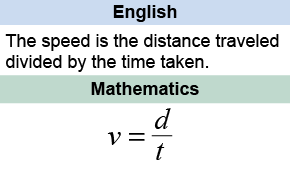|
Physics is not a subject that exists in isolation from everything else you learn. Historically, science has been closely intertwined with advances in technology, the engineering design process, and mathematics—and the connections will continue into the future. This book will help you draw those connections among the STEM (science, technology, engineering, and mathematics) disciplines. 
|
Language of physics
|
Suppose someone offered to pay you “a lot” for your favorite shirt. The description “a lot” is a qualitative statement because it does not give a numerical value. But what is “a lot”? You need a quantitative answer to that question (such as $100) to make a decision. Physics involves both qualitative and quantitative explanations. 
|
Mathematics is the language of quantitative relationships. It is a language with symbols and grammar, just like English, Spanish, Arabic, or any other language. While there are 6,000 spoken human languages, there is only One mathematical language—everyone on the planet speaks the same one. If you were born in the USA, English may seem easier than math, but that is because you have a lot more practice at it. 
|
 One of the goals of physics is to express natural laws in the quantitative language of equations. Equations are useful because they can be used to predict results—such as when, where, or how much—with numerical clarity. For example, the equation for speed is v = d ÷ t. If you travel 480 miles and it takes you 4 hours then this equation tells you that your average speed is 480 ÷ 4 = 60 miles per hour. An equation defines the relationship between its variables for all values those variables can have.
One of the goals of physics is to express natural laws in the quantitative language of equations. Equations are useful because they can be used to predict results—such as when, where, or how much—with numerical clarity. For example, the equation for speed is v = d ÷ t. If you travel 480 miles and it takes you 4 hours then this equation tells you that your average speed is 480 ÷ 4 = 60 miles per hour. An equation defines the relationship between its variables for all values those variables can have. 
|
 You will use equations in math class as well as physics. The math icon in the e-Book will guide you to real-world physics applications of concepts you learn in math class.
You will use equations in math class as well as physics. The math icon in the e-Book will guide you to real-world physics applications of concepts you learn in math class. 
|

|
Physics teaches you how to use math in the real world. A math equation might say that six equals three times two, or a = bc. Physics uses a similar relationship that says that a force of six newtons is needed to accelerate a mass of three kilograms by two meters per second every second, or F = ma. The variable names are different but the techniques are the same. Throughout the book you will find examples of how techniques you learned in math class can be applied to physics and engineering. 
|
Identify whether each of the following is a qualitative or a quantitative statement. - The sky is blue.
- That building is 50 feet tall.
- The recipe needs a dozen eggs.
- Of the 20 plants in the store, this rose is the healthiest.
 |
- This is a qualitative statement. It is a description of the color of the sky that does not involve numerical values.
- This is a quantitative statement. It is a description of the height of the building that involves a numerical value: 50 feet.
- This is a quantitative statement. “Dozen” refers to a specific number of eggs: twelve.
- This is a qualitative statement. Although the phrase mentions a numerical value, the main description of the rose is about a unquantified quality: health.

|
Physics uses equations to quantify the behavior of objects in the real world. For example, a cart accelerates—or speeds up—as it rolls down a hill. An onlooker wants to know the value for the acceleration of the cart.
A physics relationship states Acceleration is equal to the final velocity minus
the initial velocity, divided by the elapsed time. Using the variables a for acceleration, vi and vf for initial and final velocity, and t for time, write an equation to express this relationship for acceleration.
 |
This equation expresses the relationship among acceleration, velocity, and time. 
|

